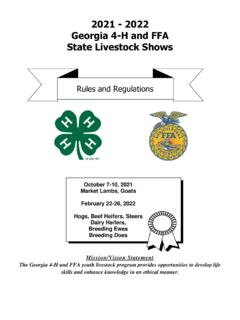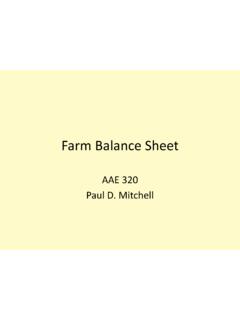Transcription of Working Safely Around
1 (800) 321-OSHA (6742) Working Safely Around Manure Storage Structures A common function of farm operations is the storage and distribution of liquid and solid manure. Manure storage structures (also referred to as waste storage facilities) can expose farm workers to toxic gas, oxygen deficient atmosphere, fire, explosion, mechanical, and drowning hazards. These hazards may severely injure or kill farmworkers as well as their would-be rescuers. Proper structure identification, worker training, and implementation of a safety and health program that includes an emergency action plan is the first step to keeping workers and their families safe Around manure ponds, lagoons, tanks, and and CharacteristicsManure storage structures are common on farms with livestock operations. Storage structures may vary based on the animal, geographic location of the farm, use of the manure, and physical consistency of the manure. Three primary types of manure storage structures and their typical characteristics are summarized below.
2 The safe work practices, in the following section, apply to any type of manure storage Pond/LagoonManure TankManure PitLocationOutdoorsAbove or below groundIndoors underneath livestock houseCeiling UncoveredEnclosed or openEnclosed. Ceiling is often slatted/slotted floor for livestockWalls and bottoms Lined with water-resistant materialsPre-fabricated vertical side walls and impervious floorLined with water-resistant materialsPermanent LaddersNoYes, inside and outsideYes, insideVentilation SystemNoNoYesPermit-required Confined SpaceNoCould beCould beOther CharacteristicsOften surrounded by grassy surface and bordered by four-foot fence with secure gateLimited means of entry or exitAttached pump-out pitCrust-like surfaces that trap gases can form on top of liquid manure during extended dry or cold periods, especially for open/uncovered Work PracticesGeneral/Management Agitation, Pumping, and RemovalFire/ExplosionConfined Space AccessEmergency and RescueManure safety is critical, regardless of where and how the manure is stored.
3 To stay safe: Limit access to authorized personnel, and never work alone. Inspect periodically to ensure that storage structures never leak or overflow. Inspect manure structure ventilation system regularly and prior to entry. Keep access ladders in good repair and free from obstruction and debris to reduce slipping. Install barriers on piers and push-off platforms to prevent vehicles from falling into ponds and lagoons. Provide guardrails or metal grill covers for all trap doors, floor holes, and wall openings. Guard manure augers, chains and sprockets, belts/pulleys, cables/pulleys, and manure scrapers to prevent worker contact or entanglement. Follow lockout/tag out procedures for machinery, and shut off and remove agitation and pumping equipment before performing services or repair activities. Use lights at night. Use extra caution during hot weather as dangerous gases may , pumping, and removal often release trapped toxic gases, such as hydrogen sulfide, methane, ammonia, and carbon dioxide.
4 These gases can expose workers to asphyxiation, fire, and explosion hazards. To stay safe: Measure and monitor atmospheric conditions and know the warning signs of toxic gas exposure. Train workers to stay at a safe distance, as built-up gases can quickly overcome them if a crust-like surface opens. Remove workers and livestock from manure pits or buildings before agitation; allow gas to dissipate and test atmosphere using remote means before entering the structure. Agitate ponds and lagoons during windy conditions to allow gases to dissipate properly; assess wind direction and stay upwind. Operate fans during agitation and pumping to maximize ventilation. Wear a multi-gas monitor when performing agitation, pumping, or from barn heaters, electrical equipment, or welding ( hot work ) can cause fire or explosion. To stay safe: Identify ignition sources that may cause fire or explosion. Use intrinsically safe or explosion-proof ventilation equipment. Prohibit smoking or the use of open flames.
5 Keep an ABC-type fire extinguisher near each exit and train workers to use them; otherwise, train workers to leave the area and contact first responders. Establish a permit system to control and monitor welding, brazing, or torch cutting. Complete a Job Hazard Analysis (JHA) and have each employee review it before conducting hot work. Ventilate and test atmosphere before, during, and after hot work. Cover manure pit slatted floors with flame-resistant tarps when performing hot typically arise during the repair and cleaning of tanks or pits. The most common hazard is hazardous atmosphere (toxic gases). To stay safe: Develop and maintain a written confined space entry program where workers enter permit-required confined spaces. Post warning signs in the language of the worker at permit-required confined space entries. Never work alone. Have another person remain outside the tank or pit and maintain visual or verbal contact. Use powered ventilation systems suitable for use in a flammable environment to maintain safe air quality inside the tank or pit.
6 Use a portable multi-gas detector in the tank or pit to test atmosphere before entering; wear a multi-gas monitor while Working in the confined space. Train workers on how to use and maintain respiratory protection and other protective equipment. Wear a body harness and lifeline attached to a tripod and a winch for easy retrieval when Working inside a response is critical for saving an incapacitated worker in a manure storage structure. Would-be rescuers may become victims themselves. To stay safe: Develop and maintain an emergency action plan. Review the emergency action plan with workers and perform drills; know emergency response time. Provide a Working phone and post emergency contact numbers within 50 feet of a manure storage structure. Keep designated escape paths free of obstructions. Train in rescue operations; keep a rescue pole, rope, and other lifesaving equipment near ponds and lagoons to allow for non-entry rescues. Never attempt a rescue unless trained and wearing proper respiratory protection, such as a supplied air system or self-contained breathing apparatus.
7 Rescuers must be physically capable of using a tripod retrieval system for confined space the space immediately and seek help, if you experience:irritated eyes, nose, or throat headache dizziness drowsiness confusion nausea or vomiting rapid or difficulty breathing increased heart (800) 321-OSHA (6742)OSHA 4166-11 2021
















